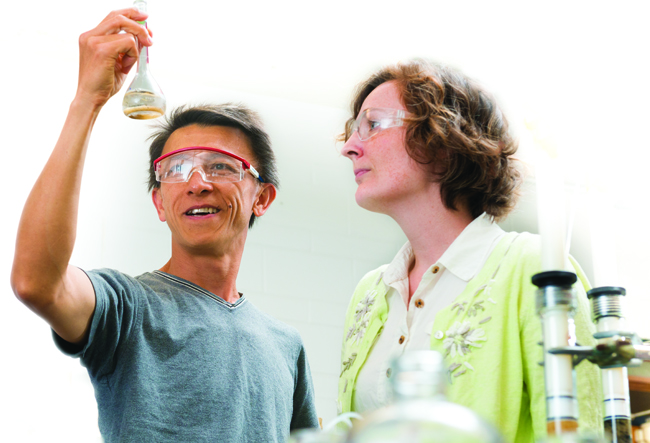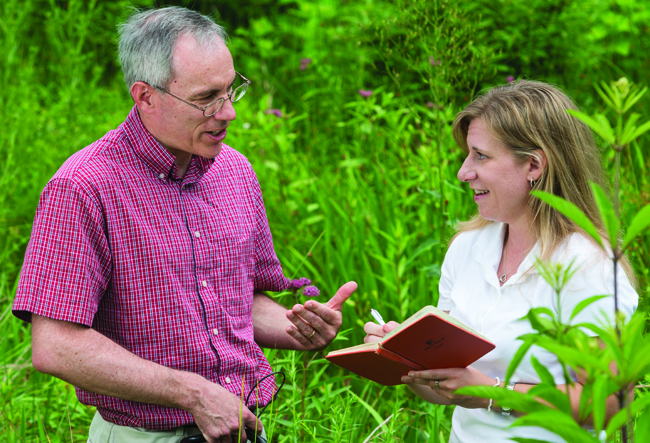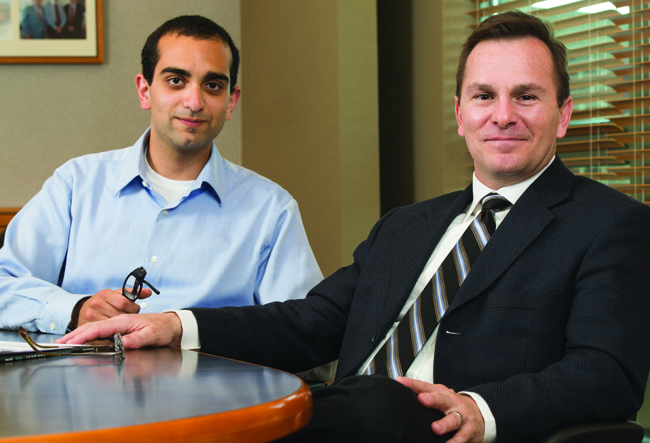



Great teams can solve great problems. As researchers on interdisciplinary teams well know, such collaborations can push you out of your comfort zone and wind up launching entire new academic fields like bioengineering. A major ISE Lab focus is the environment, bringing together scientists, engineers and policy experts to look at both problems and opportunities.

EXPLORING BIOCHAR
Pei Chiu and Julie Marseca are investigating uses for charcoal or "biochar," ranging from enriching soil to filtering pollutants from stormwater.
Imagine a technology that simultaneously enriches the soil, neutralizes pollutants and removes carbon dioxide from the atmosphere. What would such a technology look like?
According to an enthusiastic group of researchers at the University of Delaware and Delaware State University (DSU), the answer may well be "a black powder"—charcoal.
The substance is garnering new attention from soil scientists, biologists and environmental engineers worldwide. Dubbed "biochar," especially when used as a soil amendment, charcoal is increasingly being investigated as a "carbon sink"—a means of sequestering carbon and returning it to long-term storage in the ground, both enriching the soil and mitigating global warming.
UD's ISE Lab will likely become a hub for biochar research in the coming years as interested faculty and students from a number of departments including biological sciences, civil and environmental engineering, and plant and soil sciences take up residence, use the core facilities and make the building a meeting place.
When organic matter—which could range from chicken litter to corn stalks to wood chips—is subjected to very high temperatures, combustion results as long as oxygen is present, and the carbon in the organic material is released to the atmosphere. Without oxygen, however, organic matter undergoes the process of pyrolysis, forming biochar. The word pyrolysis comes from the Greek "pyro," meaning fire, and "lysis," meaning separating, and it results in a permanent chemical change in which the carbon stays put.
When added to soil, biochar can persist for hundreds of years, with particles playing host to a wide range of beneficial microbes and turning the soil a rich, black color. Soils that are high in biochar often produce dramatically higher crop yields.
Among the UD faculty seeking new ways to put biochar to good use are several environmental engineers, including ISE Lab residents Pei Chiu and Paul Imhoff, along with Dan Cha and Julie Maresca. The group has also been collaborating with Mingxin Guo of DSU, who has been studying biochar as a soil amendment for years.
The group is looking into a combination of biochar and particles of iron to form filtration devices that can be placed in drainage ditches and retention ponds in order to treat contaminated agricultural or highway runoff.
According to Chiu, the combination of biochar and iron are more effective together than alone.
"They complement each other well," he says. "Biochar treats pollutants that iron does not and vice versa. For example, pollutants such as ammonia, metal ions and pesticides can be taken up by biochar, whereas nitrate, phosphate and E. coli can be treated with iron."
The group has been experimenting with biochar particles prepared from different types of waste biomass at different pyrolysis temperatures.
"Not all biochar is created equal," Chiu says, pointing out that the properties of biochar vary depending on the source material. Poultry litter biochar, for example, is rich in nutrients compared to wood chip char. They may also harbor different soil microbial communities.
"If the right bacteria are associated with the biochar particles, then they can help process nitrogen into nitrogen gas, which is inert and can be released harmlessly to the atmosphere," Chiu says.
Work on the stormwater filters is in its third year of funding from the Delaware Department of Transportation, with the group planning to test their device at a field site this year.
The team would eventually like to obtain a pyrolysis unit here at UD. Having such equipment would allow them to produce biochar at higher yields under a broad range of conditions, making experimental results easier to replicate and more conclusive.
To Chiu and the group, the best thing about this line of research is the potential for solving so many problems at once.
"Both the iron particles and the sources of the biochar we use in our filters are essentially waste byproducts that could otherwise become problems themselves," Chiu says. "It's good to be able to use them in a sustainable way to benefit the environment instead." —Beth Chajes

Holly Michael and Paul Imhoff aim to find out how carbon gets trapped, or sequestered, in soil instead of transitioning into more carbon dioxide that we don't need.
When a forest is converted into a farm or a housing development, there are bound to be trickle-down effects on the environment—and in some cases, quite literally.
UD researchers are examining how water flows differently, drop by drop, through the ground with changes in land use and what the impacts are on biological, geological and chemical processes at play.
The work could improve understanding of how carbon gets trapped, or sequestered, in soil instead of transitioning into carbon dioxide, of which the atmosphere already has too much thanks to pollution.
"The interdisciplinary nature helps us get at these feedbacks that you wouldn't normally characterize if you were just studying biogeochemistry without tying it to the hydrology, for example," said Holly Michael, assistant professor of geological sciences.
Michael, an expert in the interactions between surface water and groundwater, is teaming up with Paul Imhoff, professor of civil and environmental engineering, to conduct experiments in ISE Lab. Together with soil scientist Kyungsoo Yoo of the University of Minnesota, they are studying how minerals in dirt break down and chemically change when exposed to air, water and organic material, a process called weathering.
Soil in a forest is held together by tree roots in a different structure than soil in an agricultural field, which is loosened by plowing. Rainfall moves through the contrasting soil structures in each setting in different ways, and the increased surface area on soil particles in a field allows for more weathering and changes in the chemistry of water as it flows downward.
Weathered mineral surfaces are more reactive with plants and other organic matter also found in soil. The researchers will be looking at the resulting organic carbon dissolved in water and how it is getting into watersheds in greater or lesser quantities depending on the land use.
"We expect that agriculture accelerates weathering," Michael said. "This would probably increase mineral surface area, which means sequestering more carbon."
"In which case, you're kind of removing carbon from the cycle," Imhoff added. "So it's not then available to be converted into carbon dioxide and go into the atmosphere."
At ISE Lab, the researchers will put soil and sediment into tubes and add water that mimics conditions in forests and fields. They will measure changes in moisture content, how the water itself is flowing through and the weathering that happens as the water moves through the columns. They will compare the results to field tests and use the data to create models that can predict the kinds of changes that will happen because of changing land uses.
The new approach brings together various perspectives to sort out how soil, water and air interact underground.
"A lot of people study mineral weathering, a lot of people study land use, and a few people have studied the two combined—but not so much thinking also about the hydrologic feedbacks and the effect on carbon cycling," Michael said. —Teresa Messmore

Peter Attia (left) published in a major ethics journal with guidance from Tom Powers, director of the Center for Science, Ethics and Public Policy.
It's not every day that an undergraduate publishes a solo paper in a major applied ethics journal. It's even more rare when that student is an engineering major.
But that is exactly what Peter Attia, a junior chemical engineering major from Hockessin, Del., accomplished in the peer-reviewed journal Science and Engineering Ethics on Dec. 6, 2012.
In "Mega-Sized Concerns from the Nano-Sized World: The Intersection of Nano- and Environmental Ethics," he sets forth an argument for adopting a "weak anthropocentric ethic" (one that considers human interests, but not exclusively) as a practical guide for deciding when to allow the use of nanotechnologies that may have environmental consequences.
The paper arose out of an assignment in the environmental ethics course Attia took last spring: write a term paper examining an issue through an environmental ethics lens, using the framework of the various philosophies presented in class.
"When I write a paper, I usually ask the professor for feedback," Attia says, "and this time the professor said it had the potential for publication."
He then worked with that professor, Tom Powers of the Department of Philosophy who also directs UD's Center for Science, Ethics and Public Policy, to polish the article over the summer and submitted it to the journal in September.
"It went a lot smoother than I expected," Attia says. Over Thanksgiving break, he received notice that the article would be published with only minor changes.
Attia, who also received a prestigious Goldwater Scholarship this year, has been supported at UD by the National Science Foundation's Nanotechnology Undergraduate Education in Engineering (NUE) program, under the mentorship of materials science and engineering professor Ismat Shah.
Powers and Shah are co-PIs on an NSF grant supporting nanoscience and ethics education in Pakistan. Attia accompanied them there for spring break and presented his work in a joint talk with Powers, whose work is cited—but disputed slightly—in Attia's paper.
Attia is working at the DuPont Company as an intern this summer. Although unsure of his future plans, the experience has turned on a new light.
"I can see myself becoming more involved in the policy aspects of science," he says. "Maybe it will only be a sideline, but it's definitely something I'm interested in."—Elizabeth Chajes